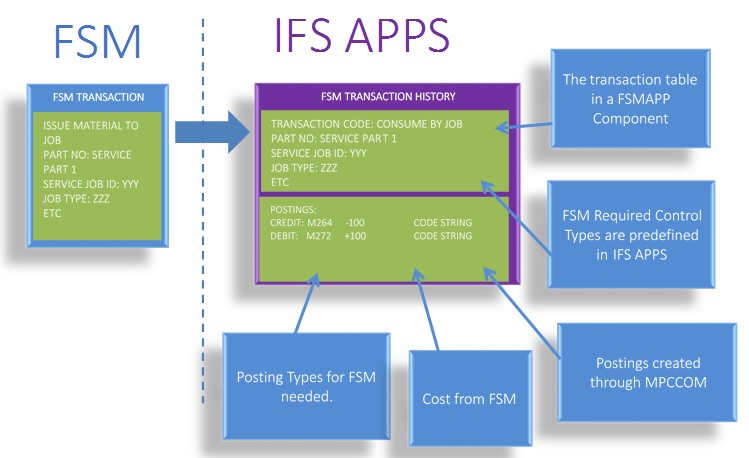
Integration between IFS Field Service Management (FSM) and IFS applications allows inventory stock maintenance using FSM while procurement and financial transactions are handled using IFS Applications.
A diagram of the integration architecture is shown below. The Integration Framework, which is a server module that generically supports inbound/outbound integrations between FSM and other systems, is included in IFS FSM APP Server. It uses import/export maps defined in the metadata of the FSM database to map XML messages and API calls between IFS Applications and FSM in a flexible way that is easily adaptable to customer needs and extensible via metadata edits in the FSM client. The standard IFS PL\SQL Access Provider is used to communicate with IFS Applications.
The SOAP Gateway of IFS Application Server gives a client or another software the possibility to integrate with the IFS business logic in a controlled and performance efficient manner. With the use of the IFS SOAP access provider format, BizAPI is invoked without any involvement of IFS Connect framework. This allows fast and efficient calling of the business logic interface and is suitable for clients where a tighter integration is preferable, resulting high performance and less administration.
Note: To be able to use integration between FSM and IFS Applications, the IFS Application end user needs to be granted with the IFS/FND Role: FND_CONNECT.
The routing address Connect to FSM server is used to make the connection between FSM and IFS Applications.
Three new outbound routing rules which are FSM- No Part Receiving, FSM- Part Receiving and IFS Applications PO Data to FSM PO are introduced to integrate IFS Applications procurement to FSM.
The following diagrams represent the process of how FSM import metadata from
IFS Applications.
Data sync process for Customer/Supplier/Part

Once the FSM transactions are generated in the part tran. Log, it will trigger the TRNASFER_FSM_TRANSACTION inbound BizApi to pass that information to IFS Applications. With the use of Operations menu option, user can view additional details in the FSM Transaction History window. The FSM transaction postings can be viewed in the Distribution and Manufacturing Postings Analysis window.
The process diagram below illustrates this process.

User can change the transaction date in this window by using the Modify Date Applied option in the Operations menu.
IFS Applications inventory transactions created corresponding to FSM inventory part transactions are as follows.
| System Event ID | System Event Description | Mapped FSM transactions |
| INTERN-IN | FSM Internal In | CC Cost
Change - 4995 BOMD De-kitting 4091 BOMK Kitting -4091 PC Physical Count in 4091 SC On Line Screen (ID) - 1400 |
| INTERN-OUT | FSM Internal Out | PC Physical Count Out-4091 PU - part that has been used-5460 BOMD De-kitting 4091 BOMK Kitting -4091 SC On Line Screen (ID) 1405 CC Cost Change - 4996 |
| EXTERN-IN | FSM External In | PD - Part Disposition-5613 RP - RC Part Change (Increased new part)-4022 RR - RC Receipt-4022 |
| EXTERN-OUT | FSM External Out | RP - RC Part Change(Decreased
old part)-5500 RQ Request-5500 SH Shipper-4021 |
| FSMPRDIFF+ | FSM Price Difference - Higher Price | |
| FSMPRDIFF- | FSM Price Difference - Lower Price | |
| FSMARRIVAL | FSM PO receipt for inventory Part |
When RQ Issue Transaction is generated in FSM, and the transaction is passed to IFS Applications by triggering the TRNASFER_FSM_TRANSACTION inbound BizApi, mapping that occurs would be as follows.
| FSM Transaction Table | ||||||||
| Transaction Code | Part No | Quantity | Unit Cost | FSM Transaction Type | FSM Info | |||
| External-Out | SEAL-123 | 10 | 50 | RQ Request Issue | Other FSM info. E.g., order references | |||
| Postings | ||||||||
| Debit/Credit | Posting Type | Value | Account | |||||
| Debit | M272 FSM External-Out | 500 | 5501 Repair Costs | |||||
| Credit | M264 FSM Inventory | 500 | 1400 - Inventory | |||||
In IFS Applications, once the FSM transactions are generated, the user can transfer them to the GL. This would create vouchers for FSM transactions in IFS Financials.
Posting control data for each financial transaction can be viewed in FSM Transaction History. This window is also used to view transaction status to ensure that there are no erroneous FSM transactions.
If the FSM transactions did not get transferred, view the details of the transaction.
Make all required corrections and then correct the transaction postings using General Data for Inventory and Distribution / Rerun Erroneous Accountings.
The Transfer FSM Transactions diagram shown below illustrates the processes